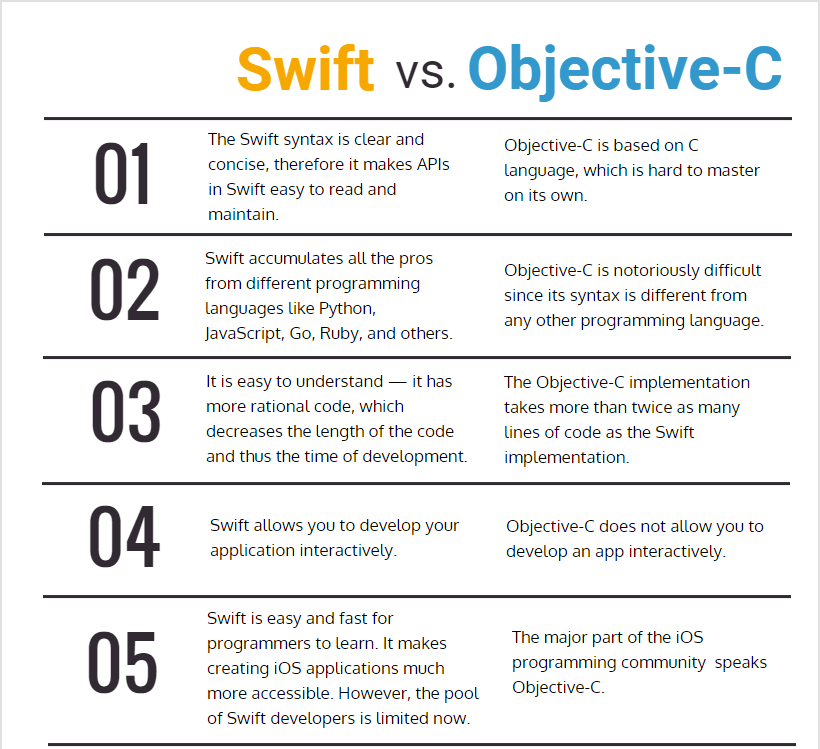The advancement in programming languages has changed the landscape of development, especially for iOS applications. Of the various known languages, two stand tall: Objective-C and Swift. While each provides something unique in either strength or weakness, we believe that the following differences between Objective-C Vs Swift will help developers make well-informed decisions to apply to their projects.
Understanding Objective-C Vs Swift:
What is Objective-C?
is an object-oriented, multi-paradigm programming language developed in the early 1980s. It extends the C programming language with Smalltalk-style messaging, which allows developers to write more dynamic and flexible code. For many years, it was the only language used for iOS and macOS development.
What is Swift?
Swift is a modern language by Apple brought into the developer’s world in 2014, which is developed to be faster safer and more expressive than Objective-C. Many advanced ideas from the current scenario of programming are employed in Swift to make the writing of code easier for developers in order that they can write clean and maintainable code.
Key Differences: Objective-C Vs Swift:
Here is the list of key differences between Objective-C Vs Swift:
Syntax
The Objective-C syntax is often wordy and a bit complicated, meaning more lines of code to do something similar in Swift. On the other hand, Swift’s syntax is cleaner and more concise. This also happens to be much readable in addition to speeding up the development process.
Example of creating an array in Objective-C:
objective
NSArray *array = [[NSArray alloc] initWithObjects:@”One”, @”Two”, @”Three”, nil];
Example of creating an array in Swift:
swift
let array = [“One”, “Two”, “Three”]
Performance
Swift was developed to outperform Objective-C in terms of performance speed. According to Apple, Swift can be up to 2.6 times faster than Objective-C because of static typing and the compiler for this language.
Optimizations in Swift:
The compiler of Swift performs aggressive optimizations in runtime performance. This includes better techniques for memory management, inline functions, and more efficient usage of CPU resources.
In benchmark tests, Swift surpasses Objective-C in most of the demanding computational tasks.
Garbage Collection vs. ARC:
Prior to ARC, Objective-C was based on a manual reference count that threw in some overhead of performance. ARC in Swift does much better and is way more efficient, managing the memory automatically and freeing the resources when required without interference from developers.
Memory Management
Memory Management Memory management in Objective C is quite difficult because one has to count the references on his or her own. ARC does help by automatically controlling the memory management, still, the developer has to be concerned about the memory leaks.
While, Memory Management Memory management in Swift is much easier, as the system fully automates ARC. The chances of memory leaks occurring are practically negligible, so developers can focus more on writing code rather than being concerned with managing it manually.
Error Handling
Objective-C Error Handling: The traditional error handling depends on the NSError objects that make the design seriously complex.
Swift Error Handling: In contrast, the Swift language has even simpler ways of error handling with the keywords `try`, `catch`, and `throw`. Hence, error handling is more intuitive, and not prone to mistakes.
Learning Curve
Objective-C Learning Curve: With its complex syntax and dependence on pointers, it makes for a steeper curve when learning for developers.
Swift Learning Curve: Modern syntax and safety-oriented make it easier for beginners to learn. Many find that they can start building applications with a greater speed as compared to Objective-C.

Source: MindK
Real-Time Case Studies: Objective-C Vs Swift
Case Study 1: Airbnb’s Shift to Swift
First, Airbnb developed their iOS app in Objective-C but ported to Swift for any new things they were building from scratch. This was on the back of a faster development cycle and performance-based necessity. The move cuts bugs by orders of magnitude while also making the overall user experience better.
Case Study 2: LinkedIn’s Adoption of Swift
LinkedIn chose Swift for developing the apps primarily because of the better performances that the apps would reap along with new features. Using the capabilities of Swift, LinkedIn greatly improved the responsiveness of the app and reduced the time taken to load to improve user satisfaction rates.
Case Study 3: Lyft’s transition from Objective-C to Swift
Lyft migrated most of its codebase from Objective C to Swift. With Swift, it reduced its code size by up to 60%. It reduced the time taken and also reduced costs associated with development.
When to Use Each Language?
Using Objective-C:
Maintenance of Existing Code:
If your company has a significant investment in Objective-C code, it may be cheaper to maintain that existing code base than to port that code into Swift. Indeed, with massive, mature applications, stability is a concern.
Integrating Legacy Systems:
Besides this, Objective C is often a better choice in cases where integration with older systems or libraries that are not compatible with Swift is an issue, especially in enterprise environments.
Using Swift:
Development Practices:
Swift promotes modern development practices such as functional programming and protocol-oriented design. If teams will be coding in this style, then Swift is a better choice.
Building Universal Apps:
Since Swift is increasingly being used not only on iOS but also in other technologies, such as server-side development and even some web applications (Swift on the server), it would be apparent that cross-platform compatibility projects could work with Swift.
Promotion of Innovation:
Swift is continuously evolving. There will be no feature lagging behind the innovation curve when the developer introduces it into the project. This can again match the innovation wish of the organization where the same wishes are to innovate rapidly and lead in this highly competitive app market.
Conclusion:
Both Objective-C and Swift prove their merits in iOS development. While stability and compatibility with legacy systems render it an obvious choice, Swift brings something more modern, hence enhancing performance, readability, and safety. The choice is yours, but it depends on which of the two best meets the requirements of your project as a whole.
We are the best and most complete iOS developers using Objective-C and Swift to create mobile apps. Are you in need of developing a new application or maintaining the current state of the application? Let our skilled team obtain for you whatever your objectives may be in as efficient and effective a way as possible.
Need iOS app development for your unique requirements? Get in touch with us right away!

Start a Project with Ajackus














